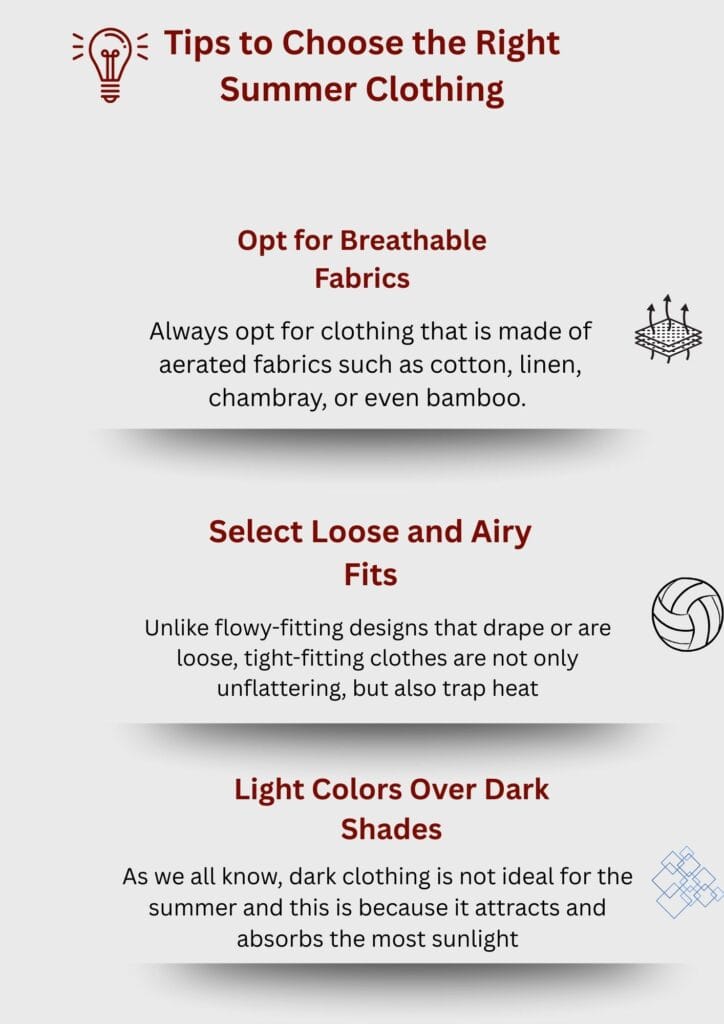Introduction
The material selection is critical during the summer months. Additionally, overheating, itching, and discomfort due to sweating is minimized with the use of breathable fabrics. Wearing the wrong fabric during summer leads to sweat accumulation, odor, and even irritation. Hence, to stay fresh, one must know which fabrics to avoid in summer. For example, synthetic and heavy textiles suffocate airflow and moisture, resulting in increased body temperature, excessive sweating, and discomfort. However, sensible fabric choices help in maintaining skin temperature and moisture. Read on to find the right summer fabrics to wear.
Worst Fabrics for Summer (List with Reasons)
Synthetic Fabrics (Polyester, Nylon, Acrylic, Rayon) – which fabrics to avoid in summer
To begin with, synthetic fabrics hinder moisture-wicking. This, coupled with the low breathability of synthetic fabrics, makes garments made out of polyester and nylon particularly discomforting during summer. In the absence of perspiration, acrylic and rayon stick to the skin, and once damp, the garments feel sticky and slow to dry. Therefore, once again, the answer to the question of which fabric to avoid in summer is undoubtedly, synthetic blends.
Polyester
Polyester traps heat against the body. In addition, the material does not allow airflow and has a slow drying rate. Thus, the accelerant in sweating and a body odor appears sooner. Thus, it is better to skip polyester blends in warmer climates.
Nylon
Similar to polyester, nylon lacks breathability too. It clings to the body, trapping moisture and sweat. In addition, it is capable of the irritation of sensitive body parts. Thus, a person frequently feels too hot in nylon garments.
Acrylic and Rayon
The same goes for acrylic, which can be warm and scratchy and feels rigid. Rayon is a semi-synthetic, which does not offer breathability when tightly woven. Thus, both fabrics can be stifling on a hot day.
Heavy fabrics (Fleece? Denim? Wool? ) Avoid in the heat
Heavy fabrics offer little breathability, and retain heat. For example, the thick denim which is perceived to be warm enough for cool weather is actually warm too. Also, fleece traps existing thermal energy, so it is not suitable during the summer. Wool offers itchy fibers, and too much insulation. Thus, all of these mentioned greatly hinder summer outings. Thus, thick materials are misleading when it comes to summer, and sit at the top.Denim
Denim conveniently traps body heat and restricts airflow. In the heat of the sun, denim feels stiff and heavy. Furthermore, sweat’s evaporation is delayed, which increases discomfort, especially in lighter washes.
Fleece
Fleece retains air and provides excess warmth. This unnecessary heat is detrimental as it causes you to overheat. Furthermore, even lightweight fleece garments are unsuitable in warm weather.
Wool
Wool provides some breathability, but heavy wool layers still insulate too much. In addition, wool garments can irritate the skin. This results in heavy wool garments providing irritant and warmth buildup during summer.
Certain Cotton-Polyester Blends (If High In Polyester)
High-polyester blends are poor for summer wear as the fabric has lower breathability. Retention of sweat can lead to skin irritating conditions due to the poor airflow in these fabrics. Cotton and linen are much better alternatives to these blends.
Polyester Cotton Blends
Fabrics with a high quantity of polyester lose venting potential, resulting in excessive perspiration along with a stickier feeling of the skin. Furthermore, poor evaporation can lead to lingering odor. Thus, even with a portion of cotton, these blends are rather unrefreshing.
Why These Fabrics Are Bad for Summer?
Heat Retention – obstructing airflow
These textiles keep heat retention and airflow obstruction close to your body. As a result, your body core temperature increases rapidly. In contrast, fabrics that are breathable allow heat to escape freely. In addition, the heat that is entrapped increases perspiration, leading to discomfort. Therefore, knowing what fabric to stay away from during the summer is airflow-blocking textiles.
Moisture Trapping – accumulation perspiration and bacteria
When moisture is retained, increased perspiration and bacteria accumulates on the surface. Due to the accumulation of bacteria, the skin odor can result and skin irritation increases. In addition, moisture-wicking fabric that does not dry fast is clammy and unpleasant. Such materials do not support comfort and personal hygiene. Therefore, do not wear high-moisture materials during hot weather.
Skin Irritation – rashes and discomfort
There are certain synthetic fibers that harshly rub against skin. Moreover, some fabrics that are heavy and coarse lead to skin rashes. In addition, the rough fabric and the perspiration that is retained leads to chafing. Hence, if fabrics are worn the wrong way, the body suffers from more than heat. Instead, opt for soft and breathable materials to eliminate rashes and discomfort.
Best Summer-Friendly Fabrics (Brief Comparison)
While you may have been interested in which fabric to avoid in summer, it is equally important to know what to wear. In this case, focusing on summer-friendly fabrics is a better approach. The ideal fabrics for summer should allow breathing, be light in weight, and absorb moisture efficiently. With that in mind, here are top picks for you to consider:
- Cotton: a fabric that is well-known for its breathability, it is a natural fabric that absorbs moisture promptly. Eager to dry, it air dries easily and softens quickly while maintaining breathability.
- Linen: arguably the most breathable fabric on the market, linen dries quite quickly. It has loose weaves which promotes airflow while moisture-wicking efficiently, which maintains dryness and freshness.
- Bamboo: incredibly soft and breathable, this natural fabric has moisture controlling abilities. Further, bamboo fabric is reported to have antimicrobial properties which helps with odor while keeping you cool.
- Chambray: this fabric has a denim look with a breezy weight. Breathability is heightened because chambray is woven from cotton and has a finer weave that denim. Thus, it offers stylish cool wear.
- Moisture-wicking Blends: Many synthetic blends are used in the production of activewear. These technical fabrics have been designed to move sweat outward and keep the wearer dry, while remaining cool and breathable. These technical fabrics help in evaporation of moisture.
Each of these fabrics delivers breathability, lightweight comfort, and moisture control. There are a number of technical fabrics that remain cool while evaporating sweat, helping maintain comfort. These breathable fabrics are in stark contrast to the types of fabrics that should be avoided in summer.
Tips to Choose the Right Summer Clothing
This guide focuses on actionable tips that will help you select the appropriate summer wear fabric.

Opt for Breathable Fabrics
Always opt for clothing that is made of aerated fabrics such as cotton, linen, chambray, or even bamboo. These fabrics not only promote ventilation, but also absorb moisture and sweat. Moreover, breathable fabrics promote the body’s cooling mechanism by allowing moisture to evaporate rapidly.
Select Loose and Airy Fits
Unlike flowy-fitting designs that drape or are loose, tight-fitting clothes are not only unflattering, but also trap heat. Always go for loose-fitting pieces that are flowy as they will keep you cool, and are additionally comfortable. Moreover, loose-fitting clothing tend to help minimize heat induced skin friction which is essential, especially for hot and humid days.
Light Colors Over Dark Shades
As we all know, dark clothing is not ideal for the summer and this is because it attracts and absorbs the most sunlight. On the contrary, wearing whites, pastels, and soft neutrals reflect light, making dark clothing unwearable. Soft neutrals are the go to, as they not only keep you cooler but also add a fresh seasonal vibe.
Read The Clothing’s Label
The clothing’s label holds give crucial information such as it’s moisture-wicking property. Look for natural fabrics if the label indicates a high percentage of synthetic fibers like polyester and nylon. Always opt for clothing with high natural fiber percentage and breathable fabrics.
Avoid Excessive Summer Layers
Too much layering worn in the summertime can trap excess warmth, so keep outfits simple. For the purpose of modesty or style, opt for sheer lightweight pieces that will not weigh you down.
Common Myths About Summer Fabrics
Even if someone keeps in mind what not to wear in the summer, some myths may still exist. Let’s clear up some misconceptions:
“All natural fabrics are good for summer”
There are people believing natural fibers such as wool or heavy cotton are ideal for the summer. Thick wool, for instance, is still a highly insulating material. In the same manner, dense cotton weaves trap heat. So not all natural fabrics are ideal during the summer. Instead, focus lightweight, breathable natural fabrics such as linen or light cotton.
“Synthetic fabrics are always bad”
The inverse is true: some people dismiss all fabrics labeled as synthetic. For example, most athletic wear made from synthetic blends is breathable and moisture-wicking. In fact, these materials perform better than some natural fabrics during sweating. Thus, not all blanket assumptions are correct without some consideration—use synthetics but only when made for breathability.
Conclusion
To summarize, knowing which fabric to avoid during the summer enables you to stay cool, dry, and comfortable. Keeping summer in mind, avoiding synthetic fabrics like polyester, nylon, fleece, and wool is best. These fabrics along with high-polyester blends trap heat and moisture, thus irritating the skin.
However, fabrics such as cotton, breathable linen, moisture-wicking technical materials, and bamboo are better options. These are lighter, breathable, and provide comfort. Following tips on light colors, loose light weaves, and fabric testing for touch further aids. Lastly, avoid myths that all natural or synthetic fabrics are the same. Prioritize fabrics based on breathability and how they handle moisture.
Remain smart, fresh, and enjoy a comfortable, breezy summer.


